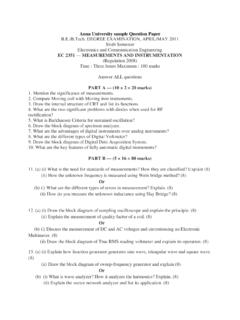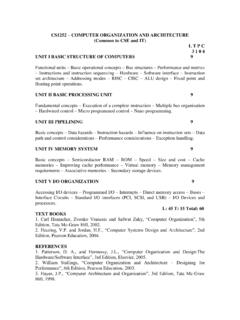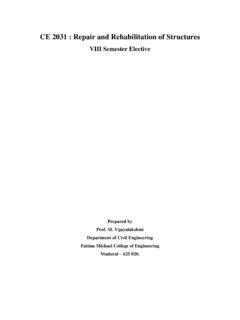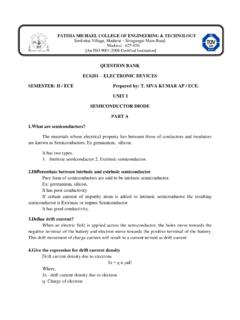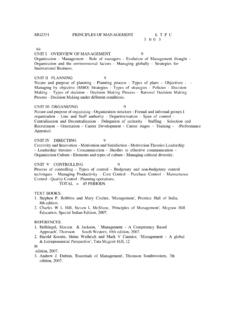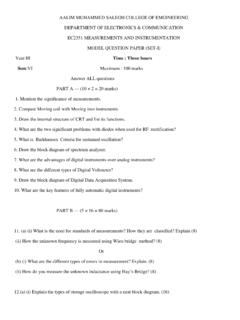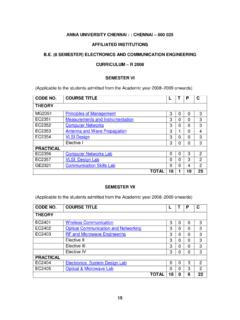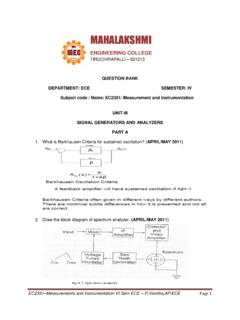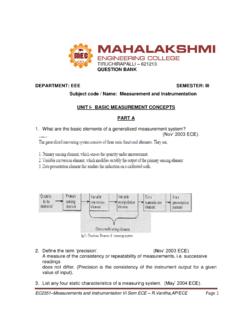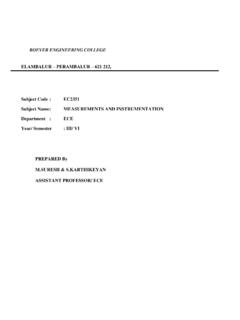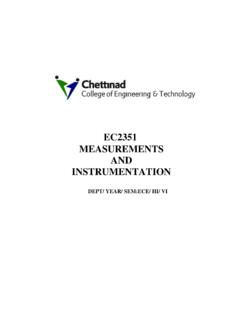Transcription of EC2351 MEASUREMENTS AND INSTRUMENTATION - Fmcet
1 1 FATIMA MICHAEL COLLEGE OF ENGINEERING & TECHNOLOGY Senkottai Village, Madurai Sivagangai Main Road, Madurai -625 020 An ISO 9001:2008 Certified Institution EC2351 MEASUREMENTS AND INSTRUMENTATION Branch: ECE Year & Semester: III & 6th Name of the Staff: , ASP/ECE2 Syllabus EC2351 MEASUREMENTS AND INSTRUMENTATION L T P C 3 0 0 3 UNIT I BASIC measurement CONCEPTS 9 measurement systems Static and dynamic characteristics units and standards of MEASUREMENTS error :- accuracy and precision, types, statistical analysis moving coil, moving iron meters multimeters Bridge MEASUREMENTS : Maxwell, Hay, Schering, Anderson and Wien bridge. UNIT II BASIC ELECTRONIC MEASUREMENTS 9 Electronic multimeters Cathode ray oscilloscopes block schematic applications special oscilloscopes : delayed time base oscilloscopes, analog and digital storage oscilloscope, sampling oscilloscope Q meters Vector meters RF voltage and power MEASUREMENTS True RMS meters.
2 UNIT III SIGNAL GENERATORS AND ANALYZERS 9 Function generators pulse and square wave generators, RF signal generators Sweep generators Frequency synthesizer wave analyzer Harmonic distortion analyzer spectrum analyzer :- digital spectrum analyzer, Vector Network Analyzer Digital L,C,R MEASUREMENTS , Digital RLC meters. UNIT IV DIGITAL INSTRUMENTS 9 Comparison of analog and digital techniques digital voltmeter multimeters frequency counters measurement of frequency and time interval extension of frequency range Automation in digital instruments, Automatic polarity indication, automatic ranging, automatic zeroing, fully automatic digital instruments, Computer controlled test systems, Virtual instruments. UNIT V DATA ACQUISITION SYSTEMS AND FIBER OPTIC measurement 9 Elements of a digital data acquisition system interfacing of transducers multiplexing data loggers computer controlled INSTRUMENTATION IEEE 488 bus fiber optic MEASUREMENTS for power and system loss optical time domains reflectometer.
3 TOTAL: 45 PERIODS TEXT BOOKS 1. Albert and William Modern Electronic INSTRUMENTATION and measurement Techniques, Pearson / Prentice Hall of India, 2007. 2. Ernest O. Doebelin, measurement Systems- Application and Design, TMH, 2007. REFERENCES 1. Joseph , Elements of Electronics INSTRUMENTATION and measurement , Pearson Education, 2003. 2. Alan. S. Morris, Principles of MEASUREMENTS and INSTRUMENTATION , 2nd Edition, Prentice Hall of India, 2003. 3. David A. Bell, Electronic INSTRUMENTATION and MEASUREMENTS , Prentice Hall of India Pvt Ltd, 2003. 4. Nakra and Choudhry, INSTRUMENTATION , Meaurement and Analysis, 2nd Edition, TMH, 2004. 5. James W. Dally, William F. Riley, Kenneth G. McConnell, INSTRUMENTATION for Engineering MEASUREMENTS , 2nd Edition, John Wiley, 2003. 3 UNIT I - BASIC measurement CONCEPTS: Functional elements of Instruments Primary sensing element Variable conversion element Data presentation element Primary sensing element The quantity under measurement makes its first contact with primary sensing element of a measurement system here, the primary sensing element transducer.
4 This transducer converts measured into an analogous electrical signal. Variable conversion element The output of the primary sensing element is the electrical signal. It may be a voltage a frequency or some other electrical parameter. But this output is not suitable for this system. For the instrument to perform the desired function, it may be necessary to convert this output to some other suitable form while retaining the original signal. Consider an example, suppose output is an analog signal form and the next of system accepts input signal only in digital form . Therefore we have to use and to digital converter in this system. Variable manipulation element The main function of variable manipulation element is to manipulation element is to manipulate the signal presented to it preserving the original nature of the signal.
5 Here, manipulation means a change in numerical value of the signal. 4 Consider a small example, an electric amplifier circuit accepts a small voltage signal as input and produces an output signal which is also voltage but of greater amplifier. Thus voltage amplifier acts as a variable manipulation element. Data presentation element The information about the quantity under measurement has to be conveyed to the personal handling the instrument or system for control or analysis purposes. The information conveyed must be in the form of intelligible to the personnel. The above function is done by data presentation element. The output or data of the system can be monitored by using visual display devices may be analog or digital device like ammeter, digital meter etc.
6 In case the data to be record, we can use analog or digital recording equipment. In industries , for control and analysis purpose we can use computers. The final stage in a measurement system is known as terminating stage . when a control device is used for the final measurement stage it is necessary to apply some feedback to the input signal to accomplish the control 0bjective. The term signal conditioning includes many other functions in addition to variable conversion and variable manipulation. In fact the element that follows the primary sensing element in any instrument or INSTRUMENTATION system should be called signal conditioning element. When the element of an instrument is physically separated, it becomes necessary to transmit data from one to another.
7 This element is called transmitting element. The signal conditioning and transmitting stage is generally known as intermediate stage. 5 measurement system: measurement system any of the systems used in the process of associating numbers with physical quantities and phenomena. Although the concept of weights and measures today includes such factors as temperature, luminosity, pressure, and electric current, it once consisted of only four basic MEASUREMENTS : mass (weight), distance or length, area, and volume (liquid or grain measure). The last three are, of course, closely related. Basic to the whole idea of weights and measures are the concepts of uniformity, units, and , the essence of any system of weights and measures, requires accurate, reliable standards of mass and length . Static Characteristics of Instrument Systems: Output/Input Relationship Instrument systems are usually built up from a serial linkage of distinguishable building blocks.
8 The actual physical assembly may not appear to be so but it can be broken down into a representative diagram of connected blocks. In the Humidity sensor it is activated by an input physical parameter and provides an output signal to the next block that processes the signal into a more appropriate state. A key generic entity is, therefore, the relationship between the input and output of the block. As was pointed out earlier, all signals have a time characteristic, so we must consider the behavior of a block in terms of both the static and dynamic states. The behavior of the static regime alone and the combined static and dynamic regime can be found through use of an appropriate mathematical model of each block. The mathematical description of system responses is easy to set up and use if the elements all act as linear systems and where addition of signals can be carried out in a linear additive manner.
9 If nonlinearity exists in elements, then it becomes considerably more difficult perhaps even quite impractical to provide an easy to follow mathemat- ical explanation. Fortunately, general description of instrument systems responses can be usually be adequately covered using the linear treatment. The output/input ratio of the whole cascaded chain of blocks 1, 2, 3, etc. is given as: [output/input]total = [output/input]1 [output/input]2 [output/input]3 .. 6 The output/input ratio of a block that includes both the static and dynamic characteristics is called the transfer function and is given the symbol G. The equation forG can be written as two parts multiplied together. One expresses the static behavior of the block, that is, the value it has after all transient (time varying) effects have settled to their final state.
10 The other part tells us how that value responds when the block is in its dynamic state. The static part is known as the transfer characteristic and is often all that is needed to be known for block description. The static and dynamic response of the cascade of blocks is simply the multiplication of all individual blocks. As each block has its own part for the static and dynamic behavior, the cascade equations can be rearranged to separate the static from the dynamic parts and then by multiplying the static set and the dynamic set we get the overall response in the static and dynamic states. This is shown by the sequence of Equations. Instruments are formed from a connection of blocks. Each block can be represented by a conceptual and mathematical model. This example is of one type of humidity sensor. 7 Drift : It is now necessary to consider a major problem of instrument performance called instrument drift.
